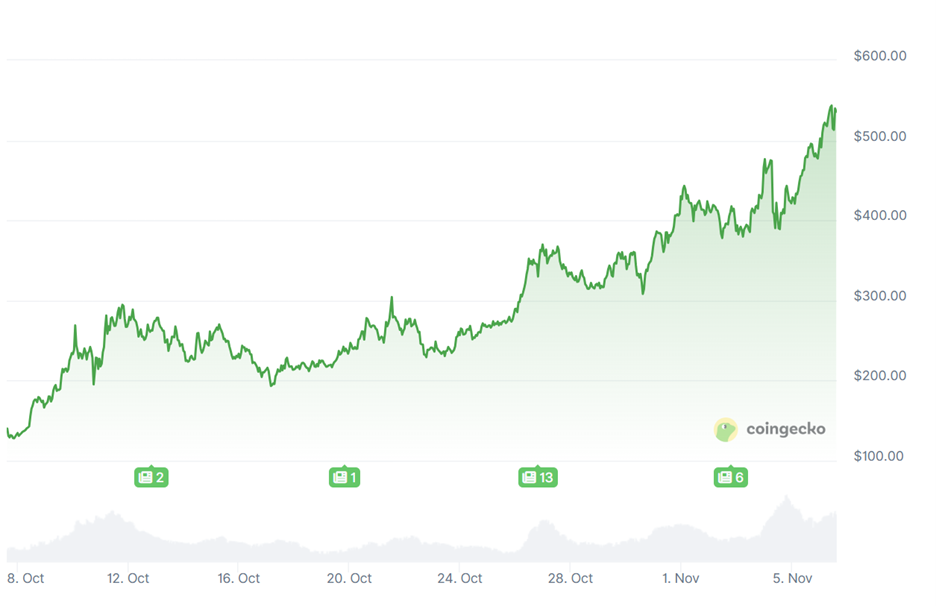Retail & Regulators Fight Over On-Chain Privacy
 |
| By Jurica Dujmovic |
After years in the shadows, privacy coins roared back into the spotlight in late 2025.
Privacy coins are cryptos that have privacy-enhancing features. They give users the ability to transact on the blockchain while maintaining a high level of privacy compared to traditional transparent blockchains like Ethereum (ETH, “A-”).
As crypto matures and know-your-customer-heavy rails spread — thanks to increased institutional adoption and regulatory support — a countertrend has gathered steam: Retail and builders rediscovering the need for on-chain privacy.
The asset leading the charge? Zcash (ZEC, “B-”).
ZEC has soared in just the past few weeks. Depending on the window you pick, multiple outlets have clocked gains between 400%–700%.
Either way, the move is unmistakable. And it makes one thing very clear: Privacy is back on the crypto agenda.
Zcash vs. Monero: A tale of Two Models
The first privacy coin, Bytecoin, was launched in 2012, but it wasn’t until 2014 that the sector really began to grow. That was when Monero (XMR, “C+”) launched as a hard fork off of Bytecoin.
Monero’s focus was on privacy by default. That meant every transaction was — and still is — obfuscated.
For years, this default privacy approach won the cypherpunk mindshare.
But while it maximizes anonymity, it also complicates centralized listing and compliance narratives.
Which is a not-insignificant part of why Zcash, not Monero, is leading the current charge.
See, Zcash features opt-in privacy. It offers two address types (transparent and shielded), to let users choose when disclosure and auditability should be allowed.
And in 2025’s regulatory climate, this flexibility is scoring points with exchanges, wallets and users who need private payments and the option to prove provenance.

3 Ways Regulation Reshapes Crypto’s Privacy Priority
The rally isn’t happening in a vacuum.
This year has been the first where regulators harmonized identity-heavy regimes globally. Several analyses this week explicitly cite the appeal of Zcash’s model amid tighter rules.
Specifically, there are three regulatory updates that have uniquely benefitted Zcash’s customizable approach to crypto privacy.
1. Travel Rule everywhere.
The Financial Action Task Force recently updated its guidance and best practices via its new “Travel Rule.” This compels Virtual Asset Service Providers (VASPs) to attach sender/recipient data to qualifying transfers.
In short, it means a world where most regulated crypto rails are traceable by design.
While it doesn’t outlaw privacy tech outright, it does push privacy to the edges of the market — self-custody, peer-to-peer and protocols that can provide verifiable disclosures when parties consent.
This sort of pendulum swing often triggers equal and opposite energy: Developers and users have begun to seek selective privacy that can coexist with compliance.
Zcash’s memo keys (and ability to reveal viewing keys) meet this world more gracefully than “opaque-always” designs.
2. MiCA’s issuer obligations.
At the same time, Europe’s Markets in Crypto-Assets (MiCA) regime is phasing in token issuer obligations. That includes white paper requirements and potential delisting risk for non-compliant assets by late 2025.
Again, there is no official “ban” of privacy coins. Still, this move raises the operational bar for listing them in the EU and nudges teams toward clearer disclosures and tools that offer more transparency.
As EU deadlines near — notably Dec. 23, 2025, for white paper compliance — token teams that want EU liquidity must up their documentation game.
I expect exchanges will begin to pressure issuers for compliance. When that’s feasible, listings can persist. Where it isn’t, liquidity may migrate offshore or to DEXes.
This paradoxically spotlights Zcash’s opt-in model: transparent by default, private when needed.
3. U.S. enforcement and AML posture.
In parallel, U.S. regulators continue to emphasize anti-money laundering expectations for VASPs, with Travel Rule compliance now table stakes.
That posture — plus actions against mixers — narrows the “fully dark” end of the spectrum while leaving space for consented privacy.
In short, asset-level bans are rare. Instead, service-level obligations are the lever of choice.
3 Fires Fueling ZEC Further
In addition to the broader regulatory landscape, there are three fires that have been lit under ZEC that is further fueling this rally.
First is that the tech finally “feels ready.”
Zcash’s big arc since 2022 has been about eliminating its controversial “trusted setup” and making private payments fast and usable.
Recently, Zcash improved scalability and lowered the friction of its shielding by default functionality.
When the user experience shifts and becomes easier to use, momentum follows.
Second is that ZEC has found its spot in the zeitgeist.
Press coverage and social catalysts poured in as ZEC’s price broke multiyear ranges, pulling derivatives and spot liquidity with it.
Coverage describing ZEC’s sudden “several-hundred-percent” run, and commentary from high-profile investors, amplified the rotation.
Once the reflexive loop spins up in crypto, it tends to overshoot.
And the third is a pipeline of product and protocol work the Electric Coin Company (ECC) has in store.
These include quality-of-life upgrades, default-shielding pushes and roadmap items like improved temporary address handling to expand practical privacy while preserving ergonomics.
These may be incremental on paper, but they strengthen the “it’s usable now” thesis that markets reward.
What the Rally Isn’t
It’s not proof that regulators embrace blanket anonymity: FATF and national agencies are moving the other way on supervised transfers.
It’s not purely tech-driven either.
Zcash’s core cryptography (Halo 2/Orchard) has been live for years, and the Zashi wallet shipped in 2024.
What changed is sentiment, usability and macro positioning — ingredients that create reflexive, sometimes overextended runs.
Which means investors watching this narrative play out should expect volatility.
Price can overshoot fundamentals, but the signal underneath is clear: Privacy features are becoming table stakes.
Your task will be to evaluate whether a project’s privacy model plays nicely with regulated endpoints. That will be a major determining factor in a project’s longevity.
Zcash’s rally may fade. Many do.
But the structural demand case (payments, payroll, DeFi receipts, commercial confidentiality) will outlast any single pump.
For users, this tells us that self-custody remains the surest way to keep private options open.
Understand your wallet’s features — e.g., shielding defaults, memo fields, etc. — and your jurisdiction’s rules for interacting with exchanges.
“Private” doesn’t mean “uninformative.” With Zcash, you can prove what you need to, when you need to.
Bottom Line
ZEC’s rally is best read as a referendum: Privacy is a feature people want, and markets will reprice assets that deliver it with credible user interface.
2025 regulation hasn’t killed privacy. It’s corralled it into more intentional, auditable channels.
And that plays directly into Zcash’s strengths.
Whether today’s prices stick is a separate (and more tactical) question.
But the strategic takeaway is durable: In a world standardizing identity on most rails, useful, selective privacy is not a niche.
It’s the next default.
Best,
Jurica Dujmovic


